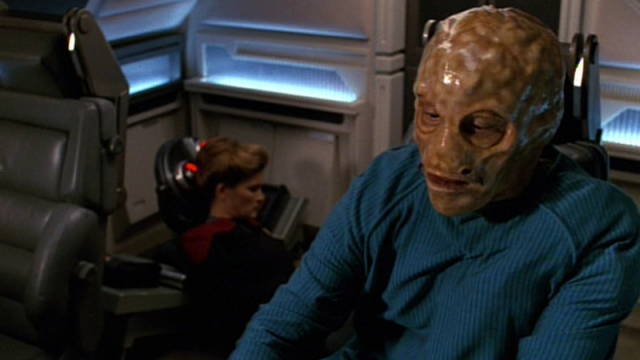Twenty-eight years ago, Star Trek asked a daring question, one fitting of a franchise that triumphs boldly going and facing the unknown: should experimental FTL travel culminate in a captain and her helmsman turning into amphibians and doing the scaly deed? The answer is unequivocally no, but it has given us a reminder that even the worst moments of a franchise as long-lived as Star Trek are occasionally worth re-evaluating.
It takes a lot to be a bad episode of Star Trek, and “Threshold” is an easy target when evaluating the many highs and lows of Star Trek Voyager. But the entire episode isn’t without merit, even if we remember it for its insane climax where Captain Janeway and Tom Paris have completely transformed into four-legged space-amphibians and procreated together before the crew can retrieve and un-amphibian them—creating what seems like the mother of all ethical workplace nightmare scenarios. But it’s a nightmare scenario that Voyager moves on from sharpishly, because, well, that’s just what Star Trek Voyager does, even with the good ideas.

“Threshold” largely deals with the titular threshold pertaining to Star Trek’s warp travel, and the challenge of putting into practice what would happen if a starship traveled beyond the seeming max speed of Warp 10. It’s a fascinating idea, one that tackles a fundamental pillar of Star Trek worldbuilding—the Warp 10 threshold had existed since the original Star Trek—and plays to the unique context Voyager found itself in. In Robert Duncan McNeill’s Tom Paris, the show had a daring pilot—discharged from Starfleet covering up a piloting error, jailed for joining the guerrilla Maquis group, and now eager to re-prove himself—willing to push boundaries. Voyager had a premise where this kind of specific boundary was begging to be pushed: stranded in the Delta Quadrant hundreds of thousands of lightyears away from home, the crew was desperate to find new ways to shave years off their decades-long journey back. The problems in “Threshold” were never to do with its ideas.
And for the most part it wasn’t to do with the execution, either. After breaking past Warp 10 in trials to find a way to get home quicker, Paris begins slowly but inevitably transforming—at first seemingly mutating, but instead according to Voyager’s holographic doctor, apparently evolving at a highly accelerated rate. It’s fascinatingly grotesque, as we see Paris slowly melt into this strange, increasingly broken being. The body horror is some of the best Trek has ever done; the scene where a mutilated Paris vomits out his tongue after lambasting Janeway for both taking pity on his grotesque form and accusing her of being jealous of his achievement, regardless of the cost, is remarkably haunting. Once again, all great ideas: effectively creepy, yes, but also a compelling bit of character work for Paris, putting him at the crucible of another accident caused by his own hubris, and seeing how, as the filters that had created the man he’d started to become on Voyager get stripped away, he deals with that scenario again.

Alas, the answer is “extremely not well,” of course, but before it can really dive into that in a meaningful way “Threshold” gets into the moment that sinks it—the rapidly transforming Paris capturing Janeway, forcing her to undergo transformation herself, and then, yes, the amphibian horizontal tango. There’s a lot of weaknesses here, even putting the unhinged idea that the show’s captain and a senior officer have space-amphibian sex aside. Voyager’s premise being that it’s so radically far away from the rest of Star Trek, physically speaking, dooms pretty much every episode early on in its run that tackles a premise where the crew get their hopes up about a potential method that could get them back home; every time, you’re inevitably waiting for the other shoe to drop well before it drops on any of its characters.
There’s also the issue of its serialization, where very little actually carries over from one episode of the series to the next—neither Paris nor Janeway ever bring up the events of “Threshold” ever again, to each other or anyone. No one addresses the ethical or moral compromise made, nor the insane implications and ramifications that amphibian Janeway and Paris leave a clutch of purportedly highly evolved human-amphibian-celerity-induced babies to disrupt the ecosystem of a planet they just happened to be passing by. Paris’ arc as a man eager to see himself redeemed by the chance he’s got on Voyager is something that persists over the rest of the show, yes, but no one ever goes into the mask that falls off here ever again.

So yes, “Threshold” is a failure of an episode in a lot of ways. And yet, the sheer outlandish goofiness of its climax has led to a softening of that failure nearly three decades later. The amphibians are the source of fan art, of jokes and memes, an earnest embrace that Star Trek can fail but still have a sense of humour about it. It may never truly shake its reputation as one of the worsts of the series, and of the franchise—but the embrace of its camp and its absurdity means that we’ve slowly come around to at least admiring the potential of “Threshold” and its better ideas. And that makes celebrating its anniversary just as fun all these years later, almost as much as taking the piss out of one of the weirdest sex scenes in Trek history is.
Want more entertainment news? Check out when to expect the latest Marvel, Star Wars, and DC releases, what’s coming to cinemas in Australia this year, and everything streaming this month across all platforms. Check out our dedicated Entertainment tab for more.
